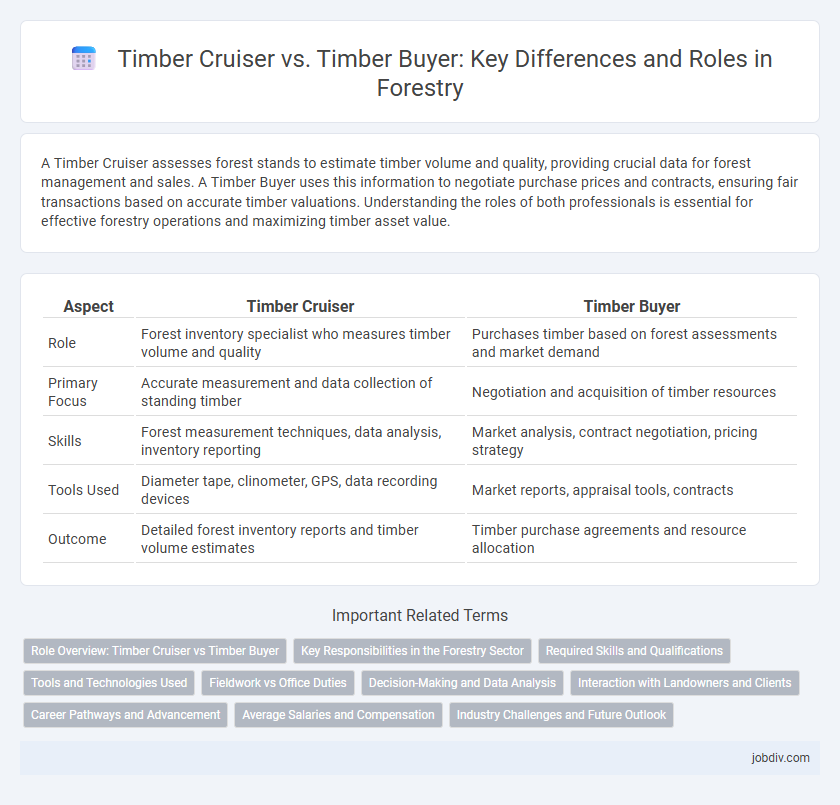A Timber Cruiser assesses forest stands to estimate timber volume and quality, providing crucial data for forest management and sales. A Timber Buyer uses this information to negotiate purchase prices and contracts, ensuring fair transactions based on accurate timber valuations. Understanding the roles of both professionals is essential for effective forestry operations and maximizing timber asset value.
Table of Comparison
| Aspect | Timber Cruiser | Timber Buyer |
|---|---|---|
| Role | Forest inventory specialist who measures timber volume and quality | Purchases timber based on forest assessments and market demand |
| Primary Focus | Accurate measurement and data collection of standing timber | Negotiation and acquisition of timber resources |
| Skills | Forest measurement techniques, data analysis, inventory reporting | Market analysis, contract negotiation, pricing strategy |
| Tools Used | Diameter tape, clinometer, GPS, data recording devices | Market reports, appraisal tools, contracts |
| Outcome | Detailed forest inventory reports and timber volume estimates | Timber purchase agreements and resource allocation |
Role Overview: Timber Cruiser vs Timber Buyer
Timber Cruisers assess forest stands by measuring tree volume, species, and quality to provide accurate inventory data for timber sales. Timber Buyers use this inventory information to negotiate prices and contracts with landowners, ensuring profitable procurement of timber resources. Both roles are essential in optimizing forest management and timber market transactions.
Key Responsibilities in the Forestry Sector
Timber Cruisers conduct detailed forest inventory assessments, measuring tree species, size, and health to estimate timber volume and quality. Timber Buyers analyze these data alongside market trends to negotiate and purchase timber at competitive prices, ensuring sustainable sourcing. Both roles require expertise in forestry practices and impact decisions on forest management and economic returns.
Required Skills and Qualifications
Timber Cruisers require proficiency in forestry measurement techniques, map reading, and species identification, alongside physical fitness for fieldwork and the ability to analyze timber volume and quality accurately. Timber Buyers need strong negotiation skills, knowledge of market pricing, forestry regulations, and timber classification to assess the commercial value and legality of purchases. Both roles benefit from a background in forestry, environmental science, or natural resource management, with Timber Buyers often requiring experience in business or contracts.
Tools and Technologies Used
Timber Cruisers utilize tools such as diameter tapes, clinometers, and GPS devices to assess tree measurements and forest stand conditions efficiently. Timber Buyers leverage advanced technologies including electronic scanners, digital scales, and forest inventory software to evaluate timber quality and volume for procurement decisions. Both professionals rely on drone imagery and GIS mapping to enhance accuracy in forest resource management and transaction processes.
Fieldwork vs Office Duties
Timber Cruisers primarily perform fieldwork, assessing forest stands by measuring tree species, volume, and quality to estimate timber value directly on-site. Timber Buyers focus on office duties, analyzing reports and market data to negotiate prices and contracts based on timber assessments and market trends. The division of labor ensures efficient timber valuation from field data collection to commercial decision-making.
Decision-Making and Data Analysis
Timber cruisers gather precise field data on tree species, volume, and site conditions using specialized tools, enabling accurate forest inventory assessments essential for strategic decision-making. Timber buyers analyze this detailed data alongside market trends, wood quality, and economic factors to evaluate timber value and negotiate purchase agreements effectively. The synergy between timber cruisers' data collection and timber buyers' analytical expertise ensures optimized harvesting plans and maximized financial returns in sustainable forestry management.
Interaction with Landowners and Clients
Timber cruisers interact with landowners by conducting detailed forest inventories, providing accurate assessments of tree volume and quality to support informed decision-making. Timber buyers engage directly with landowners and timber sellers to negotiate purchase agreements, focusing on price and contract terms based on market demand. Effective communication between timber cruisers, buyers, and landowners ensures transparency and fosters trust throughout the timber sale process.
Career Pathways and Advancement
Timber Cruisers conduct forest inventory assessments to estimate timber volume, requiring skills in forest measurement and data analysis crucial for advancing to supervisory or consulting roles. Timber Buyers leverage market knowledge and negotiation expertise to procure timber at competitive prices, often progressing into senior purchasing or management positions within forestry companies. Career pathways differ as Timber Cruisers focus on technical assessment roles, while Timber Buyers emphasize commercial and strategic decision-making in the timber industry.
Average Salaries and Compensation
Timber Cruisers typically earn average salaries ranging from $40,000 to $60,000 annually, reflecting their fieldwork and data collection roles in forestry. Timber Buyers generally receive higher compensation, with average salaries between $60,000 and $85,000, due to their responsibility in negotiating timber purchases and managing contracts. Compensation packages for both positions may include bonuses or commissions tied to volume and quality of timber procured or surveyed.
Industry Challenges and Future Outlook
Timber cruisers face challenges in accurately assessing forest resources due to increasing forest complexity and environmental regulations, impacting timber volume estimation and sustainable harvesting decisions. Timber buyers must navigate fluctuating market prices, supply chain disruptions, and stringent certification requirements that affect procurement strategies and cost management. Advances in remote sensing technology and data analytics promise to enhance inventory accuracy and forecasting, driving more informed decision-making for both timber cruisers and buyers in the evolving forestry industry.
Timber Cruiser vs Timber Buyer Infographic

 jobdiv.com
jobdiv.com